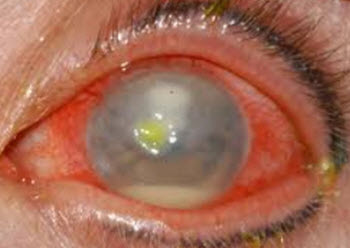Contact lenses (CL:s) increases the risk of certain medical conditions. This is due to various factors, and many of them are within our control to at least decrease the risk of even if we can’t eliminate them completely.
One risk associated with CL is the risk of the cornea not getting enough oxygen (corneal hypoxia). There are several things we can do to reduce the risk of developing complications from corneal hypoxia.
- Have routines in place that prevents you from falling asleep when using CL:s that aren’t suitable for sleeping with. Do you have a tendency to fall asleep in front of the TV at night? Switch to glasses before you sit down in front of the telly. You may also want to consider getting CL:s that are safe for use while sleeping.
- Never use CL:s longer than recommended by the manufacturer.
- Have your eyes checked once a year by an eye care professional, e.g. an optician. They can detect early warning signs.
 Another problem associated with CL:s is problems caused by pathogens such as bacteria, virus, fungi, amoebas, etc.
Another problem associated with CL:s is problems caused by pathogens such as bacteria, virus, fungi, amoebas, etc.
- Be strict about hygiene when putting in and taking out CL:s.
- Be strict about hygiene for eye make-up products.
- Avoid touching your eyes without cleaning your hands first. Also remember that pathogens can be transferred from the area around the eyes if you are scratching your eyes.
- Have a pair of glasses as back-up for high-risk situations, e.g. when you are sick with the flu or taking care of infectious family members.
- Eye abrasions will increase the risk of eye infections. Never use CL:s that hasn’t been fitted for your eyes.
- Don’t leave the CL in the eye longer than recommended.
- Discard the CL in accordance with the manufacturer’s recommendations or earlier.
- Multi-use CL:s must be properly cleaned between uses.
- If you are using multi-use CL:s, remember that the CL case can turn into a breeding ground for pathogens. Follow the manufacturer’s recommendations for cleaning, airing and replacing the case. If problems persists, you might want to consider switching to single-use CL:s.
 Corneal abrasions is another problem associated with contact lens wear.
Corneal abrasions is another problem associated with contact lens wear.
- Only use CL:s fitted for your eyes.
- When you are new to CL:s, cut your fingernails short to avoid poking yourself in the eye when inserting and removing the CL:s.
- Use moisturizing eye drops before removing the CL if the eye feels dry.
The tips above are just a few suggestions and are not exhaustive. Your eye care professional and the CL manufacturer will be able to provide you with more instructions regarding safe CL use and how you can decrease the risk of developing any of the complications listed here below.
This article was last updated on: April 24, 2016

